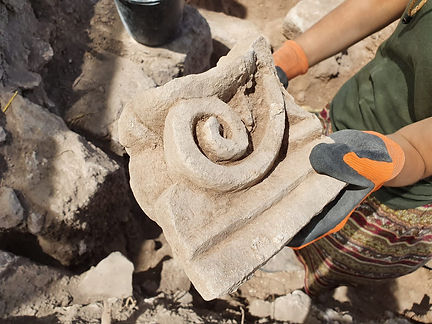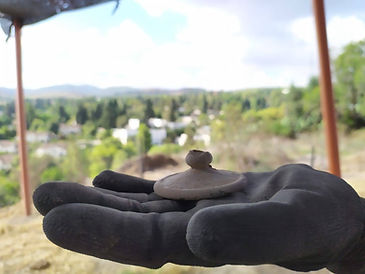Tell Abu Shusha:
Ancient Gaba
Tel Shush (Hebrew: תל שוש) or Tell Abu Shusha (Arabic: تل أبو شوشة) is a tell located next to Kibbutz Mishmar HaEmek, overlooking the Jezreel Valley. The tell's area is about 40 dunams and it rises to a height of 50 meters. The site is identified with Geva, mentioned in the list of cities conquered by Thutmose III; Geva‘ of the Horsemen, mentioned by Josephus in The Jewish War 3.3.1; and Gaba Philippi from Roman coins. The site contains remains of human settlement from the Persian, Hellenistic, Roman, Byzantine, Early Arab, Crusader, Mamluk and Ottoman periods.


An amazing multi-layered tell in the Jezreel Valley

Tell Abu Shusha is a medium-sized tell (ca. 7 ha./70 dunams) on a low chalk hill located just northwest of kibbutz Mishmar Ha-‘Emeq and southwest of Route 66, which runs from Megiddo to Yoqneam. The site is situated where Nahal Mishmar Ha-‘Emeq meets the Jezreel Valley; the wadi was an important route for transportation from the Manasseh Hills into the valley. The mound is marked by a plateau surrounded on the north, east, and south by embankments. Its southwestern side connects to a saddle coming down from the hills.
The theory that Tell Abu Shusha should be identified as the site of the important Roman city of Gaba is based on the results of 50 years of sporadic excavations at the site. Remains of the Hellenistic to the Byzantine periods include tombs, oil presses, agricultural installations, a possible dwelling, and a church. Gaba city minted its own coins, its era beginning in 60 BCE and corresponding to the governorship of Lucius Marcius Philippus in Syria.
Gaba is mentioned several times by Josephus, who first notes that Herod the Great settled his cavalry veterans there (War 3.35–36), but later suggests that cavalry on active duty were stationed there (Ant. 15.294). Herod may have promoted the settlement of Judeans in the area to help secure the trade route and natural entrance point into the Galilee from the southwest, and to prevent encroachment into the area by Tyre. In War 2.458–459, Josephus describes how Judean rebels attacked Gaba, among other places, in an early phase of the war with Rome. In Life 115–120, he notes that the city of Gaba provided fighters to the Roman commander Ebutius when he confronted Ebutius’s forces near Simonias (Tel Shimron).
A Roman-era inscription found at the site mentions a man named Abdagon (“servant of Dagon”) as the first citizen of the polis. This offers an intriguing indication for the continued worship in the region of Dagon, the old Philistine wheat god. Combine this with the evidence on the Gaba coins for the popularity of the Phrygian god Men at Gaba, and it becomes quite possible that there were not one but two cults of worship to eastern gods at the site.
Gaba’s bishops appear in acts of ecumenical councils and in later sources as well. Before the establishment of Maximinianopolis near Legio in the beginning of the fourth century CE, there was no other polis in the immediate vicinity of the western gateway into the Jezreel Valley. The Byzantine chronographer Georgius Syncellus includes Gaba in his list of cities that fell to the Hasmonean Alexander Jannaeus in the late second century BCE (Chronographia 127.2). If there is validity to the report, it would imply that a city existed there long before its founding as a polis in 60 BCE. Incidentally, the city is also mentioned in the Book of Judith (3:9–10), a work likely of the Hasmonean period, where it is positioned on the western side of the Jezreel Valley.
Come join us to discover what ancient stories Abu Shusha has to tell!
Research Goals



Following in the footsteps of a 2017 survey at the site led by Adams et al., our research goals for the proposed 2020-2023 excavations included the following:
01
Site Stratigraphy and Chronology
The Ottoman period village of Abu Shusha was set on the saddle to the west of the tell. Therefore, pre-modern strata are accessible up top and in the northern, southern, and eastern fringes. None of this has ever been excavated and we wish to do so. Accordingly, one of our primary goals is to establish the stratigraphic and chronological sequence of the tell itself. We intend only to establish a sequence, and to confirm or refute gaps that appear in the survey data.
03
Regional Setting and Cultural Interaction
Another goal of research is a regional one. We intend to piece the results of our work with the work of the JVRP and to contribute significantly to the settlement history of the region in the classical periods. Legio and Megiddo have no Hellenistic and Early Roman strata, so Tell Abu Shusha may very well fill this chronological gap and prove to be the major settlement in the western Jezreel Valley of these periods. The preliminary evidence would indicate that Tell Abu Shusha was culturally distinct in the Roman period from nearby Jewish sites such as Simonias (Tel Shimron) and Bet Shearim on the other side of the Jezreel Valley. Evidence of a Hasmonean settlement at Tell Abu Shusha—or the lack thereof—can shed light on the historical circumstances behind the founding of the polis during the governorship of Lucius Marcius Philippus in Syria in 60 BCE.
05
Economy and Production
Alongside the excavations of the site itself, we intend to run an archaeobotanical project in the so-called “linen production” installations discovered on the northeastern hill of the nearby kibbutz.
02
Site Identification
The size of the mound and the numismatic finds, among other indicators, suggest that the site should be identified with Gaba, as described above. We seek to shed further light on this identification through excavations on the mound, addressing the question of whether this indeed was the site where a polis was established after the reforms of Pompey in 63 BCE, where Herod settled his cavalry, and where there was a seat of a bishop in the Byzantine period.
04
Urban Landscape and Institutions
If the site is indeed to be identified with Gaba, this would give us an opportunity to excavate a virtually unknown Roman polis in Israel. A polis in the Hellenistic and Roman period is often, and rightfully, envisioned as a well-built environment marked by an orderly set of transacting streets, adorned by temples, and dotted by the customary agora/forum, theaters, bathhouses, and other amenities of classical civilization. Such are the well-known poleis of Palestine such as Scythopolis, Caesarea, Ascalon and all others, even the small hilltop polis of Hippos/Sussita. Such settlements may have very long histories; places such as Anthedon, Azotus, Jaffa, and Adora perhaps received civic status from Pompey or one of the subsequent governors Syria in the 60s and 50s BCE. Some of them are known as coin minting poleis in the third century CE (e.g., Jaffa and Anthedon) but almost nothing is known about their physical layout. There is also an opportunity here to discover new dimensions of cultic life in Roman Palestine, with indications that there were cults of worship of the old Philistine wheat god Dagon and the Phrygian lunar god Men at the site.

